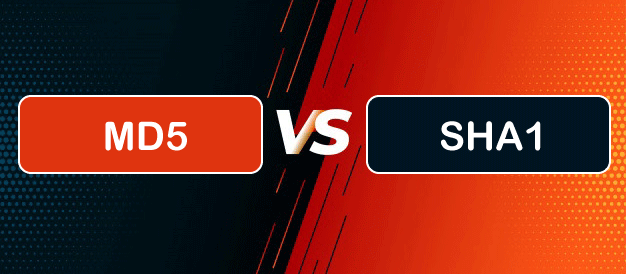Difference between MD5 and SHA1MD5 and SHA1 are hashing algorithms, with MD5 beating SHA in terms of performance. SHA1 is, nonetheless, more secure than MD5. The idea behind hashing algorithms is that they are used to establish a unique digital fingerprint of data or a message, known as a hash or digest. In this article, you will learn about the difference between MD5 and SHA1. But before discussing the differences, you must know about MD5 and SHA1, with their advantages and disadvantages. What is MD5?MD is an abbreviation for "Message Digest". The message digest algorithm known as the MD5 was designed and developed by Ron Rivest. However, other versions of the MD algorithm have been developed, the first being the MD (message digest algorithm), which was followed by MD2, MD3, MD4, and, finally, MD5. Each new edition of MD was getting better than the previous one as they were released. The fastest algorithm created at the time, MD5, could shield itself from collisions. Currently, it might not guarantee security because hackers and technology have figured out how to cause collisions. It generates 128-bit messages by processing the input text in 512-bit blocks that are further splited into 16 32-bit sub-blocks. The MD5 method produces four 32-bit blocks that together form a 128-bit message digest. Use of MD5 AlgorithmIt was created with security in mind, as it accepts any size input and returns a 128-bit hash value as an output. MD5 must meet two requirements to be called cryptographically secure:
MD5 was originally designed to hold a one-way hash of a password, and some file servers additionally offer a pre-computed MD5 checksum of a file, which the user may compare to the checksum of the downloaded file. MD5 checksum utilities are included in the distribution packages of most Unix-based OS. Advantages and Disadvantages of MD5There are various advantages and disadvantages of MD5. Some main advantages and disadvantages of MD5 are as follows: Advantages
Disadvantages
What is SHA1?SHA is an abbreviation for "Secure Hash Algorithm". SHA is a hash algorithm developed and released as a Federal Information Processing Standard (FIPS PUB 180) by NIST and NSA in 1993. SHA1 was the improved version of SHA that was released in 1995 as FIPS PUB 180-1. On the other hand, SHA1 is related to MD5 because it is based on MD5. The SHA 1 algorithm may take any arbitrary 264-bit message as input and generate a 160-bit message digest. SHA is an abbreviation for Secure Hash Algorithm, where secure refers to the algorithm's one-way property and inability to generate a comparable message from two messages. One-way implies that the original message cannot be obtained using the message digest of that message. Usage of the SHA AlgorithmThese SHA algorithms are utilized in security apps and protocols such as TLS, IPsec, PGP, SSL, and S/MiME. These also have a position in the bulk of cryptanalytic techniques and coding standards, which are primarily geared at seeing how all governmental, institutions, and private organization functions. Today, major corporations such as Google, Microsoft, and Mozilla have begun to encourage the use of SHA-3 and have stopped the use of the SHA-1 algorithm. Advantages and Disadvantages of SHA1There are various advantages and disadvantages of SHA1. Some main advantages and disadvantages of SHA1 are as follows: Advantages
Disadvantages
Key Differences between MD5 and SHA1
There are various key differences between MD5 and SHA1. Some main differences between MD5 and SHA1 are as follows:
Head-to-head comparison between MD5 and SHA1Here, you will learn the head-to-head comparisons between MD5 and SHA1. The main differences between MD5 and SHA1 are as follows:
ConclusionThe key distinction between MD5 and SHA1 is that MD5 was previously developed and had many flaws that might result in message digest clashes. On the other side, SHA1 improved hashing significantly and is superior to MD5. However, several flaws in SHA1 have been fixed in SHA 256 and SHA 512.
Next TopicDifference between
|
 For Videos Join Our Youtube Channel: Join Now
For Videos Join Our Youtube Channel: Join Now
Feedback
- Send your Feedback to [email protected]
Help Others, Please Share










